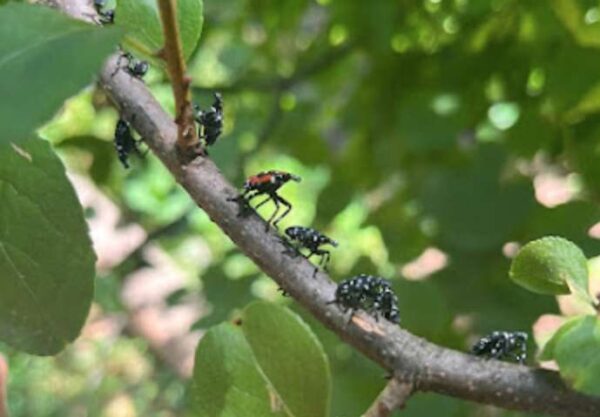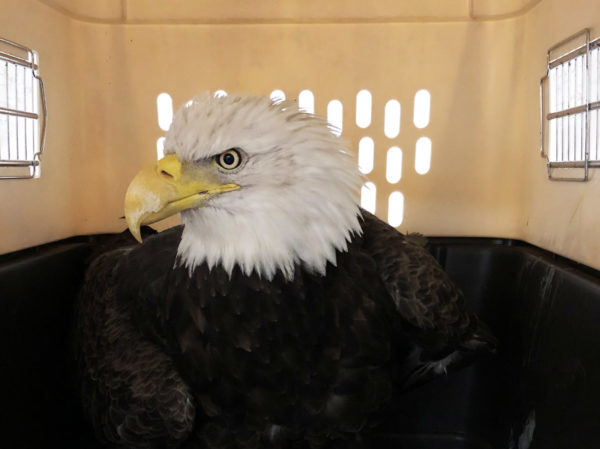
Residents in Arlington and Alexandria can now report suspected sightings of the spotted lanternfly, an invasive insect spreading around the region.
Master Gardeners of Northern Virginia has launched an online survey for people to report suspected cases of the spotted lanternfly. The organization is a volunteer group working to promote “environmentally sound gardening practices,” in partnership with Virginia Cooperative Extension, according to its website.
The survey asks people to report the location of the sighting and submit photos of what they have seen, among other information. If the insect shown in the survey is an actual spotted lanternfly, MGNV may then ask the sender to catch the insect and bring the sample to the organization.
“It may not be necessary for somebody to collect the sample, but we definitely would like pictures,” said Cordelia Collinson, a summer intern who helped to set up the form.
Spotted lanternflies are currently present in several Northern Virginia counties, spanning from Augusta to Prince William, according to a national distribution map from the New York State Integrated Pest Management Program.
The invasive insect was first detected in the state in Frederick County back in 2018. Collinson and others working on the reporting project saw the bug in Leesburg, in Loudoun County, last week as well.
“The spotted lanternfly is spreading throughout Virginia, we predict that it is coming towards us, we just don’t know when,” Collinson said.
This insect is a “potentially very serious” pest that targets grapes, peaches, hops and other agricultural crops, according to an information webpage from Virginia Cooperative Extension. It was first discovered in the U.S. in Pennsylvania in 2014.
“Just going off from the damage that happened in Pennsylvania to agricultural crops, that’s concerning for Virginia agriculturalists, especially for the grape industry, the vineyards, and also apple orchards,” Collinson said.
The state is concerned about spotted lanternflies because they are swarm feeders that suck juice out of plants, where hundreds of them may feed on the same plant at once, which may cause significant damage, Collinson said.
She added that the insect also leaves behind a sweet excrement that promotes the growth of a black mold and can attract insects like wasps. An infestation of spotted lanternflies may lead to a quarantine, where businesses in the area need to get a government permit and inspect their goods leaving the area, according to the Virginia Department of Agriculture and Consumer Services.
“Shipping and different product transportation [will be] a bit more regulated because [the state wants] to make sure that no spotted lanternflies are hiding under goods or on the other side of the truck, because that’s how they spread primarily,” Collinson said.
Spotted lanternflies are usually in their nymph stage right now and will become adults in late July. As nymphs, they are either black with white spots or red with black stripes and white dots before becoming adults. As adults, spotted lanternflies have wings around an inch long that are tan with black spots on the outside and red patches on the inside, Collinson said.
She added that because the adults usually have their wings closed, it is hard for a person to see the red patches distinctive of the species. As a result, she urged people reporting a sighting to include photos of the insect with its wings closed and open respectively.
Residents keep reporting sick birds, officials investigating — “In late May, wildlife managers in Washington D.C., Virginia, Maryland, and West Virginia began receiving reports of sick and dying birds with eye swelling and crusty discharge, as well as neurological signs. No definitive cause of death is identified at this time.” [Alexandria Living]
Alexandria Aces open season at Frank Mann Field — “The Alexandria Aces took on the Gaithersburg Giants June 8 in the opening game at Frank Mann Field, losing to their Cal Ripken Collegiate Baseball League rivals 10-7. Sheriff Dana Lawhorne threw out the ceremonial first pitch with his grandson Ryan Kaskela and team owner Frank Fannon joining him on the mound. Pitcher Chris Knight from George Washington University opened the game with Matt Stone, a catcher at Georgetown, behind the plate. The team roster consists of more than 40 elite college baseball players from across the country.” [Gazette]
Office-to-residential development trend continues at Transpotomac Plaza in Old Town North — The proposed project known as TideLock would convert three existing brick office buildings at 1033, 1055 and 1111 N. Fairfax St. into residential buildings and create a new arts and retail building. The site is 1.38 acres or 60,123 square feet in size. The office buildings were formally occupied by the American Physical Therapy Association before they moved to their new office building in Potomac Yard.” [Alexandria Living]
Today’s weather — “Sunshine along with some cloudy intervals (during the day). High 86F. Winds SW at 5 to 10 mph… Scattered showers and thunderstorms (in the evening). Low around 65F. Winds WSW at 5 to 10 mph. Chance of rain 40%” [Weather.com]
New job: Autism behavior technician — “CARD Behavior Technician Trainees will be enrolled in the CARD Behavior Technician Training Program which is an Applied Behavior Analysis training program designed to prepare individuals to successfully conduct therapy sessions with CARD patients. Behavior Technician Trainees must complete all coursework and pass all required exams in order to be eligible to move into the Behavior Technician I position. Behavior Technician Trainees report to the CARD behavior analysts. This is an hourly, non-exempt, part-time or full-time position.” [Indeed]
After reports of dead fish and birds along the banks of Lake Cook, officials have investigated and found high levels of chlorine contaminating the lake.
According to Raytevia Evans, senior public information for the Alexandria Fire Department, a HAZMAT team on site confirmed high levels of chlorination.
“We received notification yesterday evening about a visible fish kill and oil-like substance on Lake Cook” Evans said. “We sent out our HAZMAT team and fire marshal’s office to investigate. They are the ones who responded that there were high levels of chlorination detected.”
Images posted in the Bring Integrity Back to Alexandria Facebook group showed dead herons, catfish and more along the banks of the lake.
The lake is immediately adjacent to Cameron Run Regional Park, a water park planned to reopen this summer.
Staff at Northern Virginia Regional Park Authority said park management is currently on scene as officials continue to investigate.
James Cullum and Vernon Miles contributed to this story. Map via Google Maps

(Updated at 12 p.m.) A bald eagle rescued on Metro tracks has died — but not before revealing something interesting.
The eagle died earlier this week after being rescued near the Van Dorn Metro station tracks and rushed to the Blue Ridge Wildlife Center in Boyce, Virginia. His broken wing was a deep fracture down to the bone, and it was located too close to his elbow to ever heal properly, said service providers at the wildlife hospital.
But Blue Ridge staff said blood tests from the bird were a surprise.
“It’s actually our first eagle in three years not to have lead in its system,” said Dr. Jen Riley, the hospital’s director of veterinary services. “We test every single bald eagle that comes in because they tend to have very high lead levels.”
Riley told ALXnow that eagles are primarily scavengers and often absorb lead by eating dead animals shot with lead bullets. “There are huge amounts of lead in Virginia because we have such a huge hunting population,” she noted.
In the past, some eagles rescued in the area have had faced long recoveries from lead poisoning, among other injuries. Riley said finding an eagle with no lead in his body probably meant he was frequently fishing in the Potomac River.
“There’s definitely an awesome population of eagles near the Potomac, but that implies they have pretty good food there,” she said of the lead test.
D.C. has sunk billions into cleaning up its long-polluted waterways, and there are signs it may be paying off: scientists are spotting more dolphins downstream, and some hope it will be clean enough for humans to swim in soon. An eagle being able to regularly fish from the water may be another good sign — but Riley cautioned that a fish shortage might then have driven the bird to seek other prey.
“They probably just have a good amount of dead mice or rats along Metro tracks,” she said of her guess why two eagles this year have been found near the tracks. “Raptors in general are on our roads for that reason.”
Both raptors were transported to the National Eagle Repository, which collects deceased eagles for Native American ceremonies. The program is part of the Bald Eagle Protection Act, dating back to the 1940s, that restricts who can and cannot care for eagles and keep parts, like feathers. Although the eagle populations have rebounded since the country stopped using the notoriously deadly pesticide DDT, the federal protections remain in place today.
Riley said anyone who finds an eagle should contact their local animal control, and if they’re not sure who that is, they can contact state wildlife hospitals like Blue Ridge, which will help them find the right person to help.


